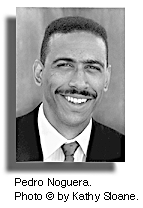

 |
 |
|
 |
Dr. Pedro Noguera is a professor of education at the University of California, Berkeley. He is also past president of the Berkeley School Board. His in depth analysis of the causes of and assessment of succesful programs for reducing and preventing youth violence is published here by In Motion magazine as a series of hyper-linked articles which can be downloaded in segments. All sections can be reached from the intro page, or readers can follow from one section to another.
How do we explain the inability of researchers in the social sciences and medicine to find solutions to the problem of youth violence? Undoubtedly, much of the frustration is due to a misunderstanding of the problem itself. The assumption underlying much of the research on youth violence is that a singular cause or set of discrete causal variables can be identified, isolated, and acted upon. Though such a model has been applied successfully in other research endeavors, it may be that certain aspects of the human condition cannot be explained through traditional forms of scientific inquiry, and youth violence may be such a phenomenon
Violence among young people must be understood as more than just an expression of aggressive individual behavior. It must be seen as part of a larger cultural phenomenon, one that is inextricably woven into the history and social fabric of our society. Though we may be repulsed by certain forms of violence, we must acknowledge that our society glorifies and is entertained by violence.
We may react strongly to child abuse or crimes against the elderly, but in our culture we honor and heap admiration upon individuals in sports or the military whose capacity for violence enables them to overcome their opponents or trounce their enemies. Violence and violent images are pervasive, infiltrating our language through metaphors and helping to define our collective sense of who we are as a people and as citizens of the most powerful nation on earth.
Violence is also a learned behavior. It may be consciously and unconsciously reinforced by families through child-rearing practices or promoted by the media and other expressions of popular culture through subtle and blatant images. Even our collective response to the threat of violence often manifests itself through some other form of violence: we sanction the killing of killers, and accept the notion that personal safety can be achieved by allowing citizens to be armed. At a visceral level, many of us seek justice for violence through some other form of violence.
Certain forms of violence (i.e. drive-by shootings) are more likely to be exhibited in specific contexts or by certain groups of people. However, even in our highly stratified and segregated communities, increasingly violence knows no limits or bounds. There is substantial evidence that violence is pervasive and not constrained by race, class, gender, or geographic location. To be sure, ours is not the only society that experiences high levels of violence, but what is uniquely American is the high rate of interpersonal violence, particularly involving young people. *35
If we accept the view of violence as a cultural phenomenon, one that is embedded in our collective history, reinforced by the media, and practiced or glorified in almost every sector of our society, then we must accept the reality that we cannot respond to it by isolating or incapacitating some number of violent individuals or targeting particular groups. Yet most of the focus of policymakers, the criminal justice system, and current research has concentrated on the violent behavior of a particular group -- young Black and Latino males -- and on manifestations of violence in low-income urban areas.*36 Popular images of violence in our society have become intimately associated with young, urban, Black and Latino males. This is due both to the rate at which incidents of violence occur in these areas and among this segment of the population, and also because of perceptions and stereotypes that are rooted in our history of racism and discrimination. It is sensible to concentrate research on, and develop interventions for, those segments of the population that have been most likely to exhibit or become victims of violence; however, by overlooking the broader cultural manifestations of violence, we not only add to the marginalization and stigmatization of the targeted group, but also ignore the host of factors that contribute to the persistence of this problem throughout our society.
Responding to violence as a cultural phenomenon has important implications for the interventions and long-term solutions that are devised to address its expression among youth. This focus compels us to examine the ways in which violence is promoted in our society and how it may be normalized as a part of social interaction among certain subcultures.*37 It also helps us to analyze how violent behavior may be produced in particular contexts through the interaction of individuals and groups and the social environment.
